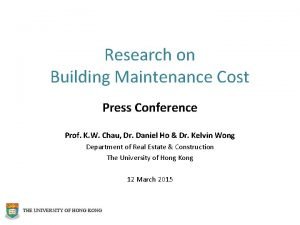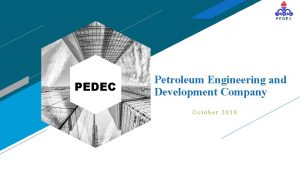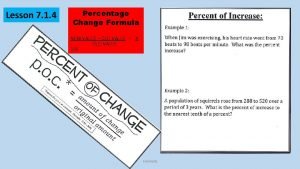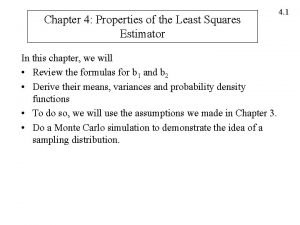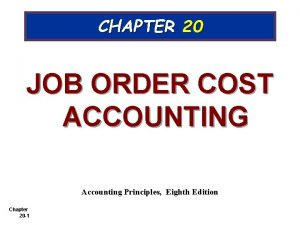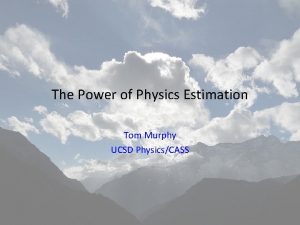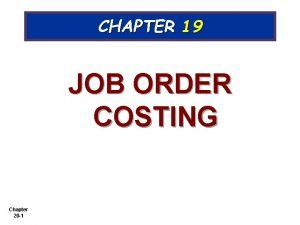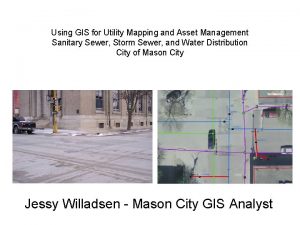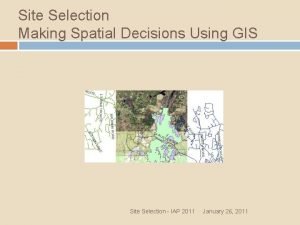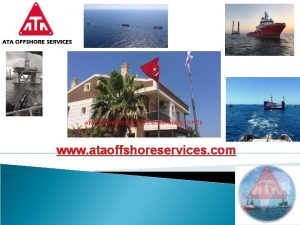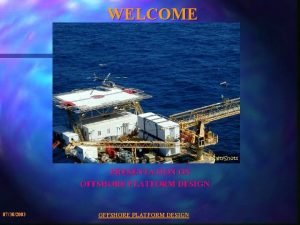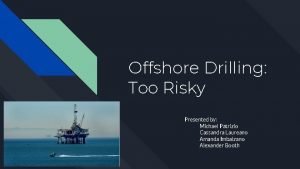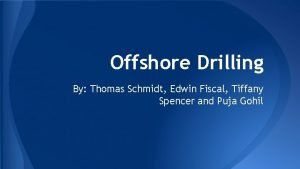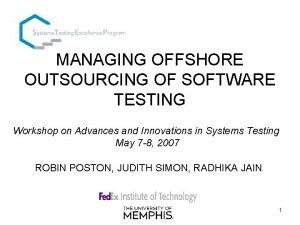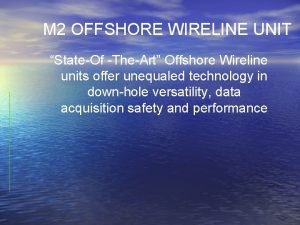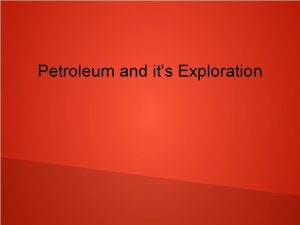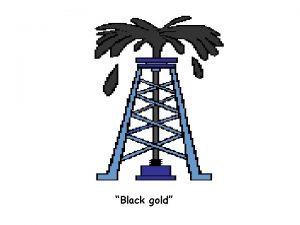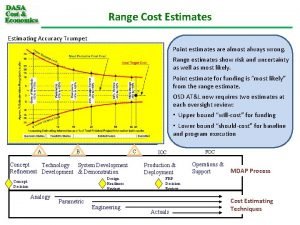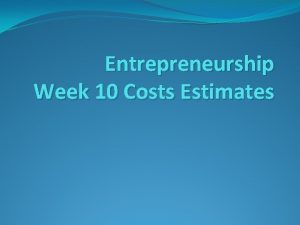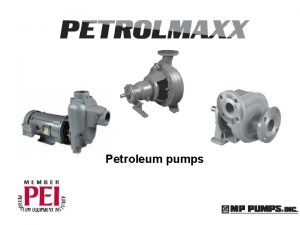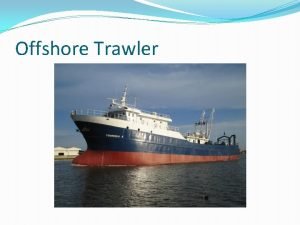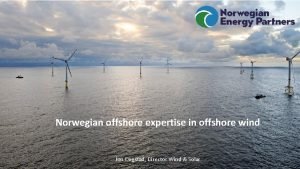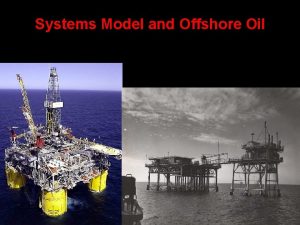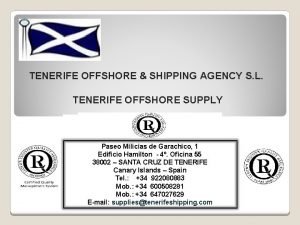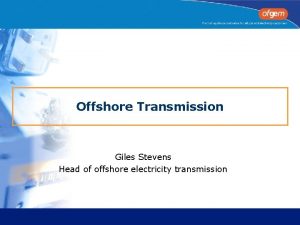Early Offshore Petroleum Development Cost Estimates Using GIS





















- Slides: 21

Early Offshore Petroleum Development Cost Estimates Using GIS Narmina Lovely, GEOG 596 A Advisor: Patrick Kennelly

Outline • Introduction – the Business Challenge • Summary of Discovery to Development Process • Spatial Characterization of Prospects and GIS Methodology • Engineering Characterization of Prospects • Integration of GIS with Other Applications • Presentation of Results • Conclusion and Future Steps 2

The business challenge • Estimate petroleum development costs to guide exploration program • Automate, standardize and codify engineering cost estimation 3

The business challenge While X has bigger volume, Y might be a better value 50$ a barrel 15$ a barrel TD: 25000 TD: 20000 WD: - 5365 WD: - 4964 VOL: 310 VOL: 250 AGE: Miocene Pressure: 28378 psi Pressure: 24480 psi HC Type: Oil 4

Discovery to Development Process Appraisal well Exploration well Appraisal well Exploration • • Exploration prospect inputs − − − − Outline of prospect area Well location Reserve Size Water Depth Target Depth Fluid Type Expected Pressures Output is well cost and well timing Appraisal • • Number of appraisal wells determined by reserve size Output is well cost(s), seismic cost, and timing Field Development • Based on logic from tool which will be seen in upcoming slides • Output is all development costs and production forecast for life of field 5

Spatial characterization of developments • Well Spacing Calculation • Bottom Holes Placement • Maximum Drill Reach Calculation • Drill Center Distribution • Gathering System Alignment for Multi- 3000 feet 30 o drill Center Scenarios • Generation of Tie-Back Options 6

Spatial characteristics of developments Well Spacing Calculation INPUTS: Hydrocarbon type Prospect Area and Shape Maximum Volume per Well 7

Spatial characteristics of developments Bottom Holes Placement 8

Spatial characteristics of developments Maximum Drill Reach Calculation INPUTS: 3000 feet Target Depth Water Depth Maximum drill reach Spatial Well Distribution 30 o 9

Spatial characteristics of developments Drill Center Distribution 10

Spatial characteristics of developments Gathering System Alignment for Multi-drill Center Scenarios INPUTS: Center of the Prospect Drill centers Spatial Distribution 11

Spatial characteristics of developments Generation of Tie-Back Options INPUTS: Hydrocarbon Type Platforms Spatial Distribution 12

Engineering characterization of prospects Engineering characterization of developments • a. Drilling performance and well types • b. Completion technologies and configurations • c. Production facilities and tie-backs • d. Additional production parameters 13

Engineering characterization of prospects Drilling Performance and Completion Technologies • • Drilling performance (days to drill 10, 000 ft) • Varies by geologic target • Well tangibles vary by geologic target Drill rig day rates ($/day) – company rates • 3000 feet 30 o Rig type MODU or Platform Rig • Type of Well Exploration, appraisal, or development • Completion type Wet tree or dry tree • Maximum drill reach • Establishes number drill centers required 14

Engineering characterization of prospects Production Facilities and Tie-backs Typical Wet Tree Development • Wet Tree Local FPS host cost a function of: • Peak field production • Water injection requirements • Number of wells • Shut in Tubing Pressure • Water depth • • Dry Tree local FPS host cost a function of: • • • Peak field production • • • Number and type of wells Water injection requirements Drill rig requirements (Dry tree development only) Shut in Tubing Pressure Subsea tie-back to existing FPS host • Oil – 25 mile radius Gas – 75 mile radius Subsea cost a function of: • • Number of wells Number of drill centers Distances between drill centers Shut in Tubing Pressure Water depth 15

Engineering characterization of prospects Additional Production Parameters • Field production forecast is the sum of individual wells brought online per drilling and completion schedule. Well forecasts utilize initial rate, reserves per well, and decline by geologic age. • Water injection wells are the ratio of producing wells with well depth consideration. • Optimize facility options (dry tree versus Subsea tie-back) based on number of wells at each drill center • Export pipeline cost included to existing FPS’s within 30 miles or nearest one • Matches facility cost spending profile with first oil date • Facility abandonment and salvage cost included 16

GIS and Information Technology applied Flow of Automation Spatial characterization of developments Arc. GIS & ET Geo. Wizards Engineering characterization of developments MS Excel Organization of results MS Access Presentation of results Power. Point VBA Automation 17

Organization of results A 18

Prospect. X SS Development w Semi Host Indicators(NRI) Success Ps: 25% IRR % NPV 7 ($m) % Disc. payback (yrs) IE (NPV/WI capital) Risked BP CONFIDENTIAL Capital ($m): E&A Drilling: Dev drilling: Facilities: Cap OH: Total: Gross 607 11, 788 3, 853 WI: 9% 57 1, 107 362 16, 248 1, 525 Subsurface Data: Gross recoverable mmboe Net recoverable mmboe Reserves per well mmboe/well Number of producers Number of injectors 250 63 9 27 9

Conclusions • Manual process was automated for a batch of prospects • Took days for each prospect manually, a matter of minutes automatically with favorable results • ARCGIS was a key technology to automate the calculation • Integration of GIS Technology with Access, Excel and Power. Point • Generated results for hundreds of prospects for comparison purposes: 800+ prospects, 2, 300+ development options • Future Steps: − Incorporate an economic model for the output − Simplify cost estimate updating − Incorporate portfolio analysis toolkit 20

Acknowledgements • BP Engineering Team - Engineering Characterization of developments • Charles Fried - Flow of Automation between GIS and Excel Engine • Patrick Kennelly – Penn State Program Advisor 21
 Building maintenance cost estimates
Building maintenance cost estimates The account analysis method estimates cost functions
The account analysis method estimates cost functions Pedec
Pedec Who global estimates on prevalence of hearing loss 2020
Who global estimates on prevalence of hearing loss 2020 Who global estimates on prevalence of hearing loss 2020
Who global estimates on prevalence of hearing loss 2020 Eva estimates that 475 songs
Eva estimates that 475 songs Gauss markov assumptions
Gauss markov assumptions Dcms economic estimates
Dcms economic estimates Job order costing
Job order costing Fermi estimates
Fermi estimates フェルミ推定
フェルミ推定 Marquis company estimates that annual manufacturing
Marquis company estimates that annual manufacturing Utility mapping using gis
Utility mapping using gis Making spatial decisions using gis
Making spatial decisions using gis Early cpr and early defibrillation can: *
Early cpr and early defibrillation can: * Ata offshore
Ata offshore Offshore platform design
Offshore platform design Michael patrizio
Michael patrizio Tiffany oil rig
Tiffany oil rig Offshore software testing
Offshore software testing Offshore wireline
Offshore wireline Offshore graphic design services
Offshore graphic design services
